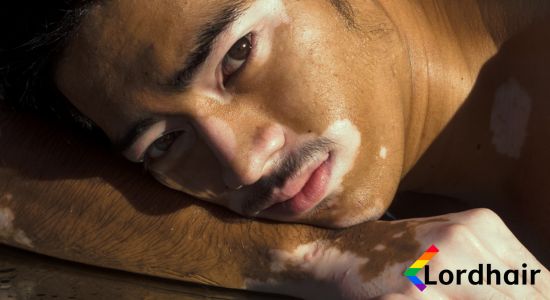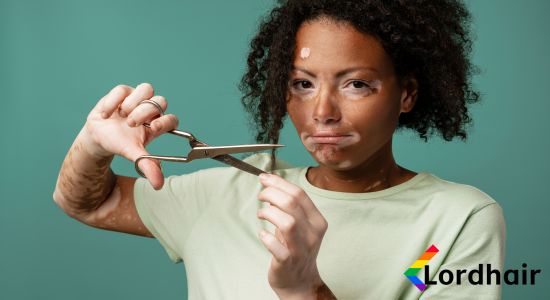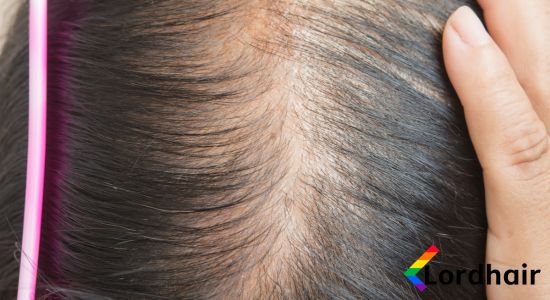Vitiligo and Hair Loss: A Closer Look at Their Connection
- Written by Ray Fernandez
- Jul 22, 2023
- |
- 7 min read
 Listen to the full text
Listen to the full text

Vitiligo is a skin condition that affects millions of people worldwide. It causes the loss of skin colour in patches, leading to white or light-coloured patches on the skin. While vitiligo primarily affects the skin, it can also have an impact on hair, leading to hair loss in some cases. In this blog, we will explore the connection between vitiligo and hair loss, as well as potential treatment options.
What Is Vitiligo?
Vitiligo is a chronic autoimmune condition that occurs when the cells responsible for producing melanin, the pigment that gives colour to the skin, become damaged or destroyed. As a result, white or light-coloured patches appear on the skin, which can affect any part of the body. The exact cause of vitiligo is still unknown, but it is believed to be a combination of genetic and environmental factors.
Hair Loss from Vitiligo
While vitiligo primarily affects the skin, it can also cause hair loss in the affected areas. When vitiligo affects the scalp, the hair follicles in the affected areas may lose their ability to produce pigment, resulting in white or grey hair. In some cases, hair loss can be more extensive, leading to complete hair loss in the affected areas.
What Are the Treatment Options for Vitiligo?
While there is no cure for vitiligo, there are several treatment options available to manage the condition and minimize hair loss. The treatment options for vitiligo include:
-
Topical corticosteroids: These creams or ointments can help to reduce inflammation and stimulate repigmentation in the affected areas.
-
Topical calcineurin inhibitors: These medications work by suppressing the immune system and can be used to treat vitiligo on the face and other sensitive areas.
-
Psoralen plus ultraviolet A (PUVA) therapy: This treatment involves taking a medication called psoralen and then exposing the skin to ultraviolet A (UVA) light. It can help to stimulate repigmentation in the affected areas.
-
Depigmentation: In cases where vitiligo is widespread and affecting a large portion of the body, some individuals may choose to undergo depigmentation treatment. This involves using topical medications to lighten the remaining areas of pigmented skin to match the depigmented areas.
Read More: Menopause Hair Loss Treatment
How to Cope with Vitiligo and Hair Loss

Hair loss can be emotionally challenging, but there are ways to cope with it. Many individuals with vitiligo find solace in support groups where they can connect with others who are going through similar experiences. Additionally, some people choose to embrace their unique appearance and find confidence in their individuality.
Vitiligo is a complex condition that can lead to hair loss in addition to its impact on the skin. If you are experiencing hair loss in conjunction with vitiligo, it is essential to speak with a dermatologist who can provide a proper diagnosis and recommend appropriate treatment options. Remember, with the right support and management plan, it is possible to live a fulfilling life, embracing your unique beauty.

What You Can Do to Care for Your Scalp
Our scalp is skin, and just like any other part of our body, it requires proper care and attention to remain healthy. Neglecting the scalp can lead to a variety of issues, including dandruff, scalp irritation, and even hair loss. Here are some tips to help keep your scalp healthy:
-
Wash your hair regularly: Cleansing your hair and scalp is essential to maintain scalp health. Use a gentle shampoo and conditioner and avoid using hot water, which can dry out the scalp.
-
Avoid harsh chemicals: Refrain from using hair products that contain harsh chemicals such as sulfates and parabens, as they can strip the natural oils from the scalp and cause irritation.
-
Protect your scalp from the sun: Wear a hat or use a sunscreen protection spray if you are spending a considerable amount of time in the sun.
-
Massage your scalp regularly: Massaging your scalp helps to improve blood circulation, which in turn, promotes hair growth. Use your fingertips to gently massage your scalp for a few minutes each day.
-
Use a scalp treatment: If you have dandruff or scalp irritation, use a medicated shampoo or scalp treatment to help soothe and heal the scalp.
Remember, a healthy scalp leads to healthy hair. Therefore, it is crucial to take good care of the scalp to prevent hair loss and keep your hair looking healthy and vibrant. If you have any concerns regarding your scalp health or hair loss, consult a dermatologist or hair care professional for proper diagnosis and treatment options.
Vitiligo and Hair Loss Connection: Final Thoughts
Vitiligo is a complex condition that can lead to hair loss in addition to its impact on the skin. If you are experiencing hair loss in conjunction with vitiligo, it is essential to speak with a dermatologist who can provide a proper diagnosis and recommend appropriate treatment options. Remember, with the right support and management plan, it is possible to live a fulfilling life, embracing your unique beauty.
Alternatively, if your hair no longer looks the colour it once did or your hair loss becomes too severe rest assured that there are hair replacement options out there for you in the form of hair systems (aka hairpieces or toupees). Hair systems are secured to the scalp with specialist tape or glue and can be worn for weeks at a time. Chat with the friendly team at Lordhair to learn more about what hair systems can do for you.
You may also be interested in:
- The link between ageing and hair loss
- Why men don't turn to others for help
- Transform the way you think about hair systems
Ray is a guest contributor to our blogs with an extensive background in PR. Ray loves to discuss his own hair system journey by offering insights into wearing and styling a hair system as well as providing observations on the role of hair in sexual and gender identity from an LGBTQ+ perspective. Be sure to check out more of Ray’s Diversity content.


